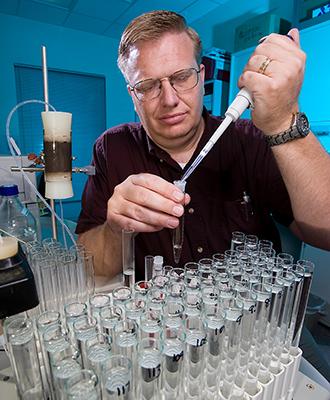Will Microplastics Endanger the Food Stream?

ARS soil scientist Clinton Williams draws samples of reclaimed water used for irrigation. (Photo by Stephen Ausmus)
It’s no secret that drought-induced water shortages cut into freshwater irrigation practices. That’s hard on the farming community, because agriculture accounts for about 85% of the world’s freshwater usage.
Treating and recycling used municipal water to make up for the shortage is not a new concept – Israel treats and reuses about 90% of its wastewater, and the Phoenix, AZ, area recycles up to 97% – but, there may be a problem with that: Microplastic.
These bits of post-consumer refuse are tiny, ranging in size from 1 micron (a human hair is 50-70 microns thick) to 5mm (about the size of a stud earring), and make their way into the sewage system. Microplastics are the result of wear and tear that breaks off of anything that contains plastic, such as clothing, dishes, or plumbing fixtures.
According to a leading environmental scientist, potentially hazardous materials can attach themselves to that plastic and enter the agricultural system via wastewater irrigation.
“Microplastics can be introduced to wastewater from multiple sources, including personal care products, laundry, and dish washing,” said Clinton Williams, soil scientist and research leader at the Agricultural Research Service’s (ARS) Water Management and Conservation Research unit in Maricopa, AZ. “Once in the wastewater these plastics can adsorb (hold onto) organic molecules, including pharmaceuticals.”
According to Williams, when the wastewater is used for irrigation or released into the environment the microplastics can accumulate at the root-soil interface. From there, the microplastics can release the pharmaceuticals where they are taken up by crops.
Further, these antibiotics could encourage microenvironments where microorganisms could develop antimicrobial resistance (AMR). AMR is a condition in which mutations cause an organism to survive exposure to an agent that had previously been used as an effective treatment.
Williams said that synthetic materials like nylon and acrylics have the highest potential to transport antibiotics. Future work will focus on quantifying the potential for these antibiotics to be taken up by edible crops consumed by people. The development of AMR is also being measured in the soil microbial community.
Wastewater is treated, but treatment plants are deigned to remove organic carbon and nitrogen. Antibiotics are at such a low concentration, typically less than 10 parts per billion, that they are not directly removed.
Williams and research partners at Clemson University and the University of North Carolina, Greensboro, are examining the interactive effects of microplastics and antimicrobials in agroecosystems by applying microplastics and antibiotics together to soils, and then measuring the development of AMR.
“[Irrigation with treated wastewater] will increase,” Williams said. “It’s a resource that can be used to increase water supplies without significant costs, [but] if microplastics are shown to increase the uptake of antibiotics and other micro-organics into food crops, there may be a need to remove microplastics from treated wastewater.” – by Scott Elliott, ARS Office of Communications

